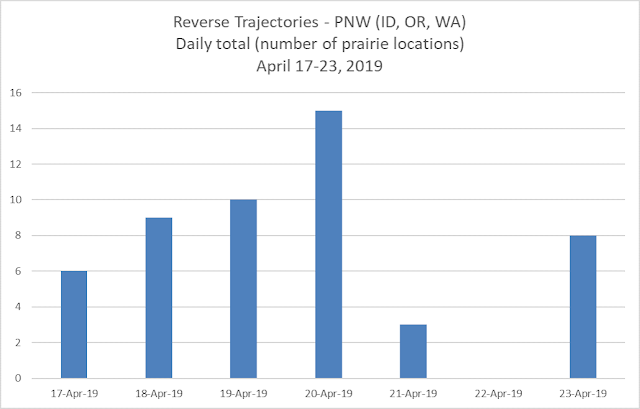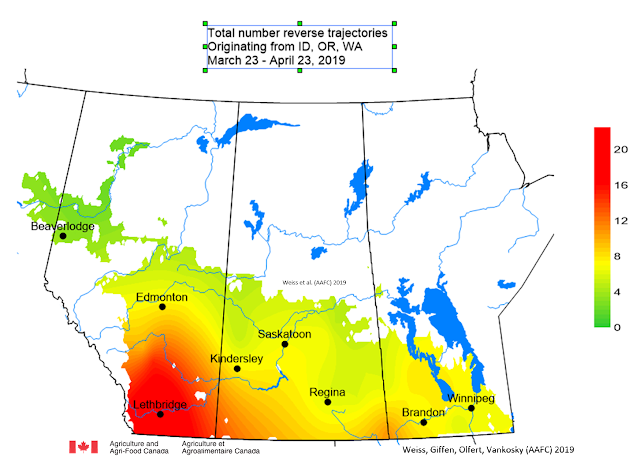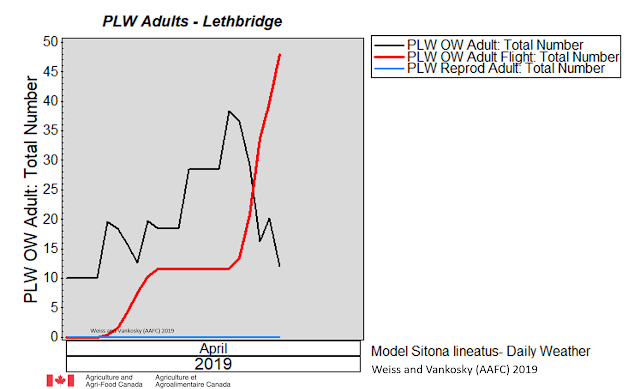Agriculture and Agri-Food Canada (AAFC) and
Environment and Climate Change Canada (ECCC) have been working together to study the potential of trajectories for monitoring insect movements since the late 1990s. Trajectory models are used to deliver an early-warning system for the origin and destination of migratory invasive species, such as diamondback moth. In addition, plant pathologists have shown that trajectories can assist with the prediction of plant disease infestations and are also beginning to utilize these same data. We receive two types of model output from ECCC: reverse trajectories and forward trajectories.
‘Reverse trajectories’ (RT) refer to air currents that are tracked back in time from specified Canadian locations over a five-day period prior to their arrival date. Of particular interest are those trajectories that, prior to their arrival in Canada, originated over northwestern and southern USA and Mexico, anywhere diamondback moth populations overwinter and adults are actively migrating. If diamondback adults are present in the air currents that originate from these southern locations, the moths may be deposited on the Prairies at sites along the trajectory, depending on the local weather conditions at the time that the trajectories pass over our area (e.g. rain showers, etc.). Reverse trajectories are the best available estimate of the ''true'' 3D wind fields at a specific point. They are based on observations, satellite and radiosonde data.
‘Forward trajectories’ (FT) have a similar purpose; however, the modelling process begins at sites in USA & Mexico. The model output predicts the pathway of a trajectory. Again, of interest to us are the winds that eventually end up passing over the Prairies.
Ross Weiss (AAFC), Meghan Vankosky (AAFC) and Serge Trudel (ECCC)
DATE: APRIL 24, 2019
Reverse trajectories (RT)
a. Pacific Northwest (PNW) – For the period of April 17-23, 2019, there have been 55 RT’s (originating over ID, OR and WA) that have crossed over prairie locations (Figs. 1 and 2). By comparison, for the period of April 10-16, 2019, there were 31 RT’s. The majority PNW RT’s have been reported to pass over southern AB. Since March 23rd, Lethbridge AB has reported the highest number of PNW RT’s (n=20), Beiseker AB (n=15) and Gainsborough SK (n=11).
 |
| Figure 1. Daily total number of reverse trajectories originating over ID, OR, and WA that have crossed the prairies. |
 |
| Figure 2. Total number of dates with PNW reverse trajectories originating over ID, OR, and WA that have crossed the prairies (since March 23, 2019). |
b. Mexico and SW USA (TX, CA) – No trajectories, originating over Mexico or southwest USA have crossed the prairies for the period of April 17-23, 2019. Since March 23, 2019 there have been 5 reverse trajectories that originated over Mexico, CA and TX. All five occurred on April 7, 2019.
c. Texas and Oklahoma – No trajectories, originating over TX or OK have crossed the prairies for the period of April 17-23, 2019. Since March 23, 2019 there have been 18 reverse trajectories that have originated over OK and TX (Fig. 3). Most of these trajectories have crossed eastern SK and MB.
 |
| Figure 3. Total number of dates with reverse trajectories originating over OK and TX that have crossed the prairies (since March 23, 2019). |
d. Nebraska and Kansas - No trajectories, originating over KS or NE have crossed the prairies for the period of April 17-23, 2019. Since March 23, 2019 there have been 18 reverse trajectories that have originated over KS and NE (Fig. 4).
 |
| Figure 4. Total number of dates with reverse trajectories originating over KS and NE that have crossed the prairies (since March 23, 2019). |
In a continuing effort to produce timely information, wind trajectory reports will be available both DAILY and WEEKLY:






















